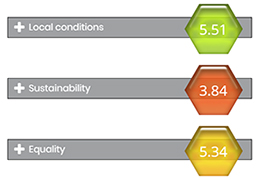
Thriving Places Wales is based on the same methodology as the Thriving Places Index (for England), and shares the same structure of Dimensions, Domains and Sub-domains. However, the indicator data that contributes to the scores at these levels differs due to the devolved nature of some of the areas covered by indicators. Where indicators differ, Thriving Places Wales uses a ‘best-fit’ principle to replicate the indicators in the Thriving Places Index. More details on how Thriving Places Wales works can be found in the Methodology tab.
Scores in Thriving Places Wales are relative to the Welsh average for that particular year. This means the Index should not be used to compare the scores of one area over time. Also, changes in the indicator list will affect the comparability of scores over time.
Because of the difference in indicators used, it is also not possible to compare areas in Wales with areas in England.
Depending on when updates for indicators were last published and the time period these cover, some indicator data used in this update may show the impact of COVID-19 (from March 2020 onwards).
Because of the methodology, the dimension scores show the smallest variation from the mean of any part of the Index. Scores range from 3.75 (for Local conditions in Blaenau Gwent) to 7.48 (for Equality on the Isle of Anglesey)
Neath Port Talbot, Rhondda Cynon Taf and Caerphilly have dimensions scores all below the Welsh average.
Nine local authority areas have two dimension scores above the Welsh average, and three local authority areas, Pembrokeshire, Vale of Glamorgan and Cardiff, have all three dimension scores above the Welsh average.
The three highest scores at the dimension level are (Isle of Anglesey, Gwynedd and Ceredigion) in the Equality dimension.
Local conditions
This local condition dimension contains five domains:
- Place and environment
- Mental and physical health
- Education and learning
- Work and local economy
- People and community.
At a domain level, scores range from 2.33 for Mental and physical health in Blaenau Gwent to 6.79 in Monmouthshire.
Every local authority area scores above the Welsh average for at least one domain.
Six local authority areas have at least four domain scores above the Welsh average, with Gwynedd and the Vale of Glamorgan, the only authorities to do so in all five domains.
Within the local conditions dimension, there are 18 sub-domains. At this level of the tool, with fewer indicators contributing to scores, there is more variation in the scores across the local authority areas.
Scores range from 0.51 (for Social isolation in Torfaen) to 8.69 (for Mortality and life expectancy in Monmouthshire).
Scores show that no one area is very good or very bad across all sub-domains. Whilst the lowest scores are most frequently seen in the South Wales Valleys, these areas also have some of the highest sub-domain scores within local conditions. For instance, whilst Blaenau Gwent has nine scores below 3.5 marks, it also has the highest scores of all local authority areas for the local environment and Housing sub-domains.
Likewise, the Merthyr Tydfil local authority area has eight sub-domain scores below 3.5 marks, but has the highest score of all local authorities for Good Jobs.
At the opposite end of the scale, Powys has five scores above 6.5 marks, but the lowest score in Wales for Transport.
Sustainability
The Sustainability dimension contains three sub-domains:
- Green infrastructure
- Waste
- Energy use.
Scores in these sub-domains range from 1.25 for Energy use in Neath Port Talbot to 6.82 in Cardiff. However, Neath Port Talbot also has the fifth highest score of all local authority areas for Green infrastructure.
Three local authority areas have three sub-domain scores below the Welsh average: Isle of Anglesey, Gwynedd and Flintshire.
Two local authority areas (Bridgend and Newport) have scores above the Welsh average for all three sub-domains.
Equality
The Equality dimension has three sub-domains:
- Health inequality
- Income inequality
- Employment inequality.
Scores range from 2.34 (for Employment inequality in Neath Port Talbot) to 9.20 (for Health inequality in Gwynedd). However, Neath Port Talbot also scores above the Welsh average for Health inequality.
Denbighshire and Bridgend score below the Welsh average for all three sub-domains.
Three local authority areas score above the Welsh average in all three sub-domains: the Isle of Anglesey, Gwynedd and Flintshire.